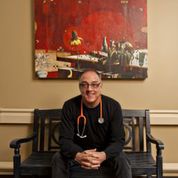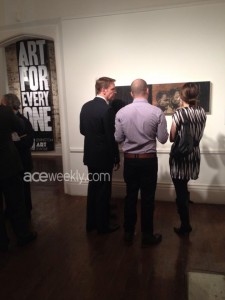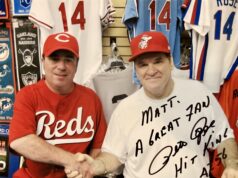
When Lexington Mayor Jim Gray introduced “The 20” an art Auction at Lexington Art League last month, he described himself as “a cheerleader and carnival barker” for investing in Art in Lexington. Three of the twenty pieces from that Auction were snapped up by Dr. Nick Kouns, a former Art League president and longtime advocate for arts in healthcare, on behalf of Clark Regional Medical Center. The pieces were “Gray’s Arch” by Guy Mendes, “The Community” by Isaac Powell, and “Things We Should Have Done But Couldn’t,” by Joseph Kuncinski. John Darko and Blake Eames have also been commissioned to provide new work. There is also a rotating exhibit of regional artists alongside the curated pieces. By the end of 2013, the permanent curated collection will contain 27 pieces.

He says, “The primary goal is to expedite the healing process through interaction with the artwork. The science of art in healthcare is definitive–art engagement makes people healthier. For example, studies show that regular artistic engagement slows the progression of Alzheimer’s dementia. Given that we have a long-term care facility physically attached to the hospital, the art is literally just around the corner from a host of elderly patients who carry a diagnosis of dementia. Plans are already underway to emulate the ‘Meet Me at MoMA‘ model at Clark Regional Medical Center.”
“The second part of our goal with the Art In Healthcare Program at Clark Regional Medical Center is to aid in the transformation of the hospital from a prototypically ‘sick’ environment to an environment that overtly promotes wellness.”
He says “The Community” by Isaac Powell, for example, has evoked appreciative response from both patients and staff, though he didn’t initially know the full circle of his connection to the artist’s history when he acquired the piece for Clark. “Isaac Powell was born without a right hand. His work was curated at the ‘2010 Revealing Culture’ exhibition at the Smithsonian Institution’s International Gallery, as part of VSA’s National Exhibition. I first worked on VSA’s ‘Side x Side’ Program here in Lexington many moons ago, along with Trish Hatler and Diane Mason over at Cardinal Hill Rehabilitation Hospital. When I learned of Isaac’s participation in VSA (an educational and granting arm of the Kennedy Center for the Performing Arts), it was like time folded back on itself. First and foremost, the art should speak for itself. His art speaks to everyone that walks by it, including me. It gives me hope.”
Colleen Swartz, UK Healthcare’s first Chief Nurse Executive, says, “A more holistic approach and focus on a healing environment has led to some substantive changes in the approach of new facilities and optimizing the care model and approaches to care.” She adds, “I got to know Dr. Kouns around 2002. He was a physician leader in the community hospital where I had taken on the role of Chief Nursing Officer. Nick has always adopted a very holistic approach to healing and medicine. His clinical acumen exceeded the ‘traditional’ practice of medicine to include other considerations such as the emotional aspects of illness, situational awareness and attention to the healing environment. I would consider Dr. Kouns a thought leader in this area.”

Trish Roberts Hatler, Development Coordinator for Cardinal Hill, says of Lexington’s evolving landscape, “the biggest change that I see is that instead of talking about how Art in Healthcare is important, we are now actually seeing that model being put into place. Just look around and you’ll see the powerhouse collection at the University of Kentucky, but there are also some smaller, charming installations at St. Joseph, Cardinal Hill Hospital and a powerful growing collection at Clark Regional Medical Center.” Having collaborated with Kouns on the Side by Side project when he was Lexington Art League president and it was introduced at Cardinal Hill, she adds, “While those examples are visual arts, there are so many opportunities and ways to include the arts in the healing environment and make the experience more positive.” (This year’s Side by Side project in Lexington will be featured at the April 19 Gallery Hop at the Living Arts and Science Center.)
Artist Lennon Michalski provided a piece for The 20 auction at LAL, and also has a piece featured in Clark’s new collection. He is also currently working on a commissioned piece for UK Healthcare. Last year, he was named one of the Hot 100 Southern Artists to watch by Oxford American Magazine (along with fellow Lexington artists Lina Tharsing and Phillip March Jones). Michalski says, “Art has an impact on the culture of a space. Art gives a sense of emotion and defines the space’s characteristics and its influence on the population. My artwork is meant to encourage hope and enjoyment.” Of the piece for Clark, he says, “I wanted people to see the process of ‘fixing/healing’ of a living being. I want them to see an operation as a positive experience, relating to those in the hospital, showing how patients will be mended back to health.”

He says, “The UK Arts in Healthcare and Clark Regional Med Center have been a wonderful help for artists. More corporate involvement would truly strengthen the artist community. Any environment with bleak walls and vacant spaces hinders the mind and spirit.”
Lexington Art League executive director Stephanie Harris echoes that sentiment and sees progress in Lexington’s corporate art collecting community: “the presence of art in businesses seems to be more highly regarded of late. There seems to be a trend toward corporate art appreciation and an acknowledgement of the benefit of inspiration in the workplace.”

Lexington artist Christine Kuhn, who’s also been a Side by Side program artist and instructor, has two pieces in the Clark collection, “Monument,” and “Galileo.” She says “Healthcare settings are getting increasingly sophisticated in their art choices. There is an increased understanding of the role of the arts in healing and of the role of varied types of artwork in the healing process. With medicine’s increased understanding of the interconnectedness of mind and body, the healing value of art becomes apparent–art is one of the few means of touching not just the rational mind, but also the subconscious emotional mind, which is a powerful source of healing.”
Harris says, “LAL envisions a world where art, artists and art-making are central to human inspiration, self realization and meaning, and The 20 was a direct result of that organizational shift.”

She adds, “Lexington is also home to collectors whose homes and offices are filled with world class, museum-grade art. Some collections even number in the thousands.”
She sees the trend growing as “more and more people are discovering and appreciating the impact that a work of art can have on everyday existence. Art is for everyone, no matter what your aesthetic or your education or your economic situation, and in Lexington, art is accessible. At LAL, we see people investing in art that they love and supporting the many incredible talented artists in our community, and I believe that trend of surrounding yourself with work that inspires you is only going to get stronger in the coming decade.”
Michalski adds the exclamation point to the conversation:
“Lexington needs to provide for the Arts like they do UK Basketball.”
—
This article also appears on page 8 of the April 11 print issue of Ace.
Click here to subscribe to the Ace digital e-dition, for 25 years of ongoing Lexington arts coverage, emailed to your inbox every Thursday morning.
To submit a Lexington, Kentucky arts news item for consideration, email acelist at aceweekly.com. To submit a Lexington Arts Event to be considered for the Ace calendar and Picks Page, go to the Ace online calendar, and click “Submit.”
Related articles
Side by Side at LASC, Gallery Hop, April 19, 2013
Art in Healthcare: Lexington Initiatives lead the way in model programs 6.17.2009
Art as a Healing Process: The Makenna Foundation Wall at UK 8.07.2003
Side by Side: Arts and Accessibility in Lexington 6.19.2008







